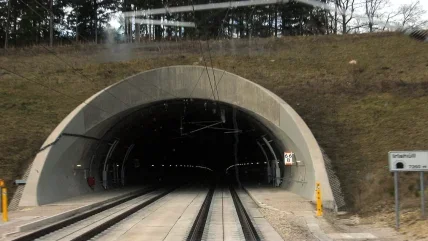
INTRODUCTION
Polypropylene (PP) fibres help improve the passive fire resistance of concrete in tunnels by the network of voids created under heat, so providing safe release of otherwise potentially explosive internal moisture and steam pressures that could trigger spalling and expose steel reinforcement. It has become, therefore, an important part of the potential range of fire safety solutions provided for underground environments.
Over the last four decades, Adfil has been developing and supplying, and improving, such monofilament PP micro fibre technology for passive fire resistance in concrete products. The company has owned the patent for 18m diameter PP microfibres, branded as Ignis and which has been extensively used in tunnels worldwide – in precast concrete linings such as for segmental rings in bored tunnels, sprayed linings for conventional excavation, or cast in-situ concrete for the final, permanent, linings to tunnels or caverns.
From the many tests Adfil was involved with it was observed that the finer the diameter of the PP fibre, the better the fibre performed. Important experimental work on the role of the diameter of monofilament micro fibres in the explosive spalling of concrete in fires was undertaken in 2010 by Professor Gabriel Alexander Khoury.1 The research then showed that the amount of spalling of structural concrete decreases by lowering the diameter of the PP fibres in the mix design.
Earlier in 2023, as part of its latest R&D programme, Adfil successfully performed key fire tests of a new, slightly slimmer size of PP fibre, helping to add a further product size to the Ignis range on offer.
The latest R&D adds a narrower PP fibre – 17m diameter – which can achieve effective performance at lower dosages in a concrete mix. The results achieved in fire tests were exceptional, according to the OBV norm.
The product was immediately launched, on all markets.
SPALLING RISK AND ITS MITIGATION
Explosive spalling of concrete is a serious concern in tunnel fires. It refers to the violent ejection of concrete fragments caused by the rapid heating and release of entrapped moisture and steam within the concrete. This phenomenon not only compromises the structural integrity of the tunnel but also poses a significant risk to the safety of tunnel users and emergency responders.
The Ignis products have been extensively tested and proven to effectively eliminate explosive spalling in concrete exposed to fire. Test facilities such as TNO in Holland and the BRE in the UK have conducted rigorous experiments that demonstrate the prevention of explosive spalling, pointing to inclusion of the narrow PP fibres in a concrete mix as a way to help drastically reduce spalling risk.
R&D: FIRE TESTS
To enhance performance of the range further, with even narrower diameter fibres, Adfil conducted fire tests with the 17μm diameter PP fibres in concrete blocks.
The tests were undertaken in April, at the Institut für Brandschutztechnic und Sicherheitsforschung (IBS), in Linz, Austria, in accordance with the OBV norm of the Austrian fire classification system. The objective was to evaluate the newly developed product in extreme fire conditions and seek to obtain the BBG fire classification at the lowest dosage possible of PP fibres in the concrete mix.
During the testing, two concrete samples of 1.8m x 1.4m x 0.5m were subjected to conditions of a RWS fire curve for 120 minutes. After only 10 minutes the temperature increased to 1200°C and subsequently reached a maximum of 1350°C after 60 minutes from the beginning of the test.
Before the start of the test, the concrete samples were put under tension loading of 0.5MPa longitudinally and 1.2MPa across the block. These loads created the standard tension in concrete that would cause it to undergo spalling quicker.
The results of these fire tests showed that by adding only 1.34 kg/m3 of the new size of Ignis PP fibres to the BBG fibre concrete mix design (April 2015 guideline) of the OBV norm, a significant outcome was then achieved: no explosive cracking and spalling was observed. There was a shallow area at the transition zone to the formwork where minor, slight, shallow spalling (a few hand-widths, only to 5mm maximum) took place.
The report of the fire tests said the mean value of the spalling depths on the entire fire-exposed surface was significantly less than 1cm.
EUROCODE 22 in Section 6 – High Strength Concrete (HSC), Chapter 6.2, recommends the use of more than 2 kg/m3 of monofilament fibres. However, this does not take into the account the diameter of the fibre nor its performance during fire tests.
This breakthrough in using narrower diameter PP fibres in structural concrete is significant for passive fire resistance in tunnel safety, mitigate the risk of spalling, and also with benefits to optimise dosages and workability, and cost-effectiveness.
CONCLUSION
Adfil has provided fire protection fibres to support tunnel safety for decades.
The recent fire tests conducted according to the Austrian fire classification system have further validated the effective performance of the Ignis range of PP fibres for passive fire resistance of concrete in tunnels.
Achieving the result of no explosive spalling with a mere 1.34kg/m3 of new, narrower diameter Ignis PP fibres incorporated into the concrete mix underscores its effectiveness for various structures in tunnels that could be subject to extreme fire conditions. By significantly reducing the risk of the occurrence of explosive spalling, the new PP fibres thereby further enhance the safety of both tunnel users and emergency responders.
The long-term economic integrity of the concrete structures are also supported.






